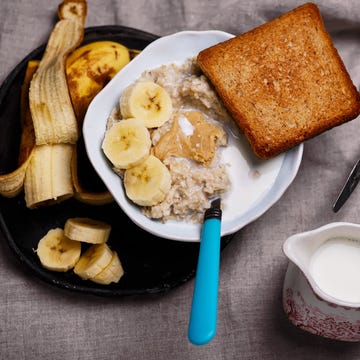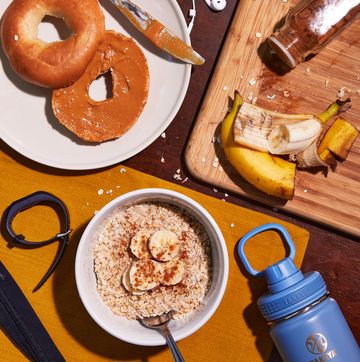Know Where to Find It
 Klaus Tiedge
Klaus TiedgeYou can find sugar by checking the ingredient list printed below the Nutrition Facts panel on most packaged foods. Added sugar goes by many names and often ends in “ose,” such as lactose or maltose or sucrose. Other names for sugar include:
- brown sugar
- cane sugar
- corn syrup
- corn sugar
- dextrose
- fruit juice concentrate
- high fructose corn syrup
- honey
- maltodextrin
- molasses sucrose
- raw sugar
- turbinado sugar
Scan the Ingredients
 Dan Saelinger
Dan SaelingerIf sugar (or a sugar from the list above) is one of the first three ingredients, think twice before choosing this food. Ingredients are listed by weight, so the ingredients that are listed first make up a greater percentage of the product.
Advertisement - Continue Reading Below
Add It Up
 Mitch Mandel
Mitch MandelTo determine if a food has added sugars (and how much), you have to do a little math. First, look at the Nutrition Facts panel and the line for total sugars. There are four calories in each gram of sugar, so if a product has 20 grams of sugar per serving, that’s 80 calories just from the sugar alone. How do you know if any of that is “added sugar”? Look at the ingredient list and see whether it contains any added sugars (like those from the list above). If it does not, the food doesn’t contain any added sugars. The sugars that come from a natural sugar like lactose (milk sugar) or fructose (fruit sugar) are often considered “healthier” simply because they come from a food that offers other nutritional benefits like calcium and vitamin D (in milk) or fiber and vitamin C (in fresh fruit). But if you see an added sugar among the first three ingredients, the product contains significant “added sugars,” and it’s best to avoid it.
Aim Low
 Rodale Images
Rodale ImagesChoose products with the least amount of added sugar. On any product, aim for no more than 2.5 grams of added sugar per 100 calories.
Advertisement - Continue Reading Below
Go Natural
 Christopher Kimmel / Getty
Christopher Kimmel / GettyChoose fresh fruit to satisfy a sweet craving; it provides vitamins, minerals, and fiber in addition to some hydration, so it will keep you feeling fuller longer.
Time It Right
 Thomas MacDonald
Thomas MacDonaldIf you absolutely need a sweet, have it in the 20 to 30 minutes after a hard workout. During that time, your body is hyper-efficient at digesting the sugar. Pair the sweet with protein, and this will kick-start muscle repair.
Advertisement - Continue Reading Below
Choose an Alternative
 Mitch Mandel
Mitch MandelIf you’re looking to add flavor to your food, reach for herbs and spices instead of sugar. Cinnamon and cloves add flavor to oatmeal, while oregano and rosemary add flavor to marinara sauce.
Know Where It’s Hidden
 Kurt Wilson Photography
Kurt Wilson PhotographyFoods like salad dressings and yogurt may not taste sweet, but sugar is often added to low-fat versions of products to make them tastier. Even foods like multigrain bread contain about 2 grams of added sugar per slice. Look for brands that have the label “no added sugar.”
Advertisement - Continue Reading Below
Watch the Substitutes
 David McGlynn
David McGlynnWith all these dire warnings about sugar, it’s tempting to reach for calorie-free artificial sweeteners. Low-calorie sweeteners have led to the creation of a wide range of low-calorie products, which offer a healthier alternative for anyone watching their weight and those with diabetes, who must carefully monitor their carbohydrate and sugar intakes. Low-calorie sweeteners have been the subject of extensive scientific research and are generally recognized as safe by the Food and Drug Administration (FDA). While the research suggests that artificial sweeteners won’t make you eat more, many people report sugar cravings and a need for more food after consuming “diet” foods sweetened with sugar substitutes. In addition, many report that once they cut back on the artificial sweeteners, their cravings ebbed, and it was easier to resist sweet temptations and lose weight.
Advertisement - Continue Reading Below
Readers Also Read
Advertisement - Continue Reading Below
Advertisement - Continue Reading Below






















